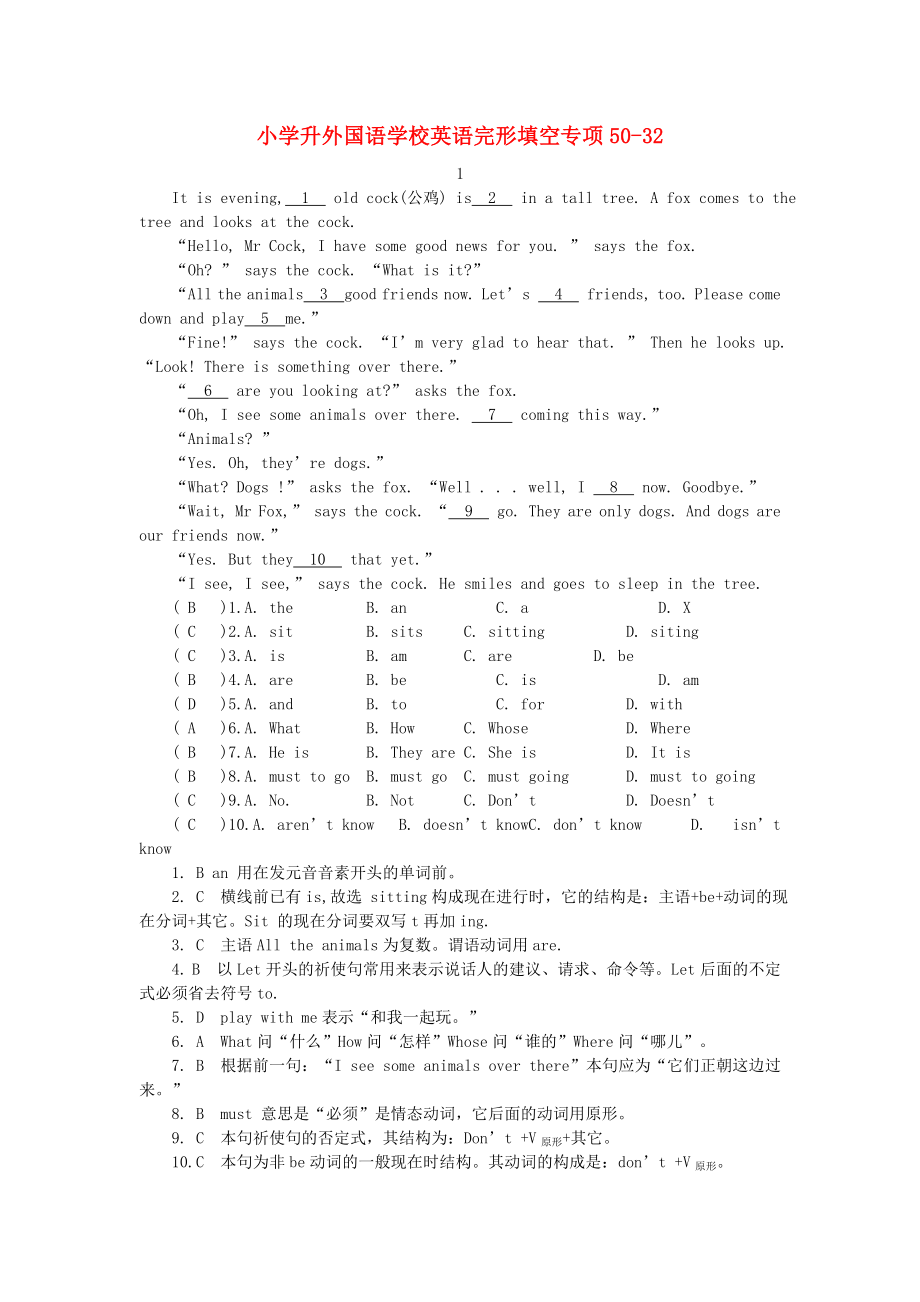《寧夏外國語學(xué)校小升初英語專項(xiàng)訓(xùn)練 完形填空32》由會(huì)員分享,可在線閱讀�,更多相關(guān)《寧夏外國語學(xué)校小升初英語專項(xiàng)訓(xùn)練 完形填空32(2頁珍藏版)》請(qǐng)?jiān)谘b配圖網(wǎng)上搜索。
1���、小學(xué)升外國語學(xué)校英語完形填空專項(xiàng)50-32
1
It is evening, 1 old cock(公雞) is 2 in a tall tree. A fox comes to the tree and looks at the cock.
“Hello, Mr Cock, I have some good news for you. ” says the fox.
“Oh? ” says the cock. “What is it?”
“All the animals 3 good friends now. Let’s 4 friends, too. Pl
2����、ease come down and play 5 me.”
“Fine!” says the cock. “I’m very glad to hear that. ” Then he looks up. “Look! There is something over there.”
“ 6 are you looking at?” asks the fox.
“Oh, I see some animals over there. 7 coming this way.”
“Animals? ”
“Yes. Oh, they’re dogs.”
“What? Dogs
3、 !” asks the fox. “Well . . . well, I 8 now. Goodbye.”
“Wait, Mr Fox,” says the cock. “ 9 go. They are only dogs. And dogs are our friends now.”
“Yes. But they 10 that yet.”
“I see, I see,” says the cock. He smiles and goes to sleep in the tree.
( B )1.A. the B. an C. a D. X
4�����、( C )2.A. sit B. sits C. sitting D. siting
( C )3.A. is B. am C. are D. be
( B )4.A. are B. be C. is D. am
( D )5.A. and B. to C. for D. with
( A )6.A. What B. How C. Whose D. Where
( B )7.A. He is B. They are C. She is D. It is
( B )8.A. must to go
5�����、 B. must go C. must going D. must to going
( C )9.A. No. B. Not C. Don’t D. Doesn’t
( C )10.A. aren’t know B. doesn’t knowC. don’t know D. isn’t know
1. B an 用在發(fā)元音音素開頭的單詞前�。
2. C 橫線前已有is,故選 sitting構(gòu)成現(xiàn)在進(jìn)行時(shí),它的結(jié)構(gòu)是:主語+be+動(dòng)詞的現(xiàn)在分詞+其它���。Sit 的現(xiàn)在分詞要雙寫t再加ing.
3. C 主語All the animals為復(fù)數(shù)�����。謂語動(dòng)詞用are.
6���、
4. B 以 Let開頭的祈使句常用來表示說話人的建議、請(qǐng)求�����、命令等����。Let 后面的不定式必須省去符號(hào)to.
5. D play with me表示“和我一起玩?���!?
6. A What問“什么”How問“怎樣”Whose問“誰的”Where問“哪兒”。
7. B 根據(jù)前一句:“I see some animals over there”本句應(yīng)為“它們正朝這邊過來����。”
8. B must 意思是“必須”是情態(tài)動(dòng)詞����,它后面的動(dòng)詞用原形。
9. C 本句祈使句的否定式�,其結(jié)構(gòu)為:Don’t +V原形+其它。
10.C 本句為非be動(dòng)詞的一般現(xiàn)在時(shí)結(jié)構(gòu)��。其動(dòng)詞的構(gòu)成是:d
7�、on’t +V原形。
2
Xiao Ning: Mum, could you help 1 , please?
Mum: Certainly! 2 wrong?
Xiao Ning: Something is wrong 3 my watch.
Mum: 4 worry, let me have a look, please.
Xiao Ning: Here you are.
Mum: 5 you have a knife?
Xiao Ning: Yes. But I can find it. Where is it?
Mum: O
8�、h, there! I think 6 under your bed.
Xiao Ning: Yes, there 7 .Here you are.
Mum: Xiao Ning, you must 8 your things. Now our watch is 9 .
Xiao Ning: 10 very much.
Mum: That’s OK.
( D )1.A. him B. my C. her D. me
( C )2.A. what’s B. What C. What’s D. Which’s
( C
9、)3.A. on B. in C. with D. for
( A )4.A. Don’t B. Do C. Not D. don’t
( C )5.A. Are B. Have C. Do D. Don’t
( C )6.A. its B. It’s C. it’s D. it
( A )7.A. it is B. are C. you are D. is it
( D )8.A. look like B. look at C. look D. look after
( B )9.A. f
10、ine B. OK C. broken D. right
( A )10.A. Thanks B. Thanks you C. Thank D. Thankes
1. D 本句屬于兩人之間的對(duì)話���,應(yīng)填第一人稱���,help為動(dòng)詞,后面的代詞用賓格形式�。
2. C What’s wrong? 意為“怎么啦 ?” 用于詢問對(duì)方某人或某物出了什么問題����。
3. C 當(dāng)敘述某一東西出了毛病時(shí)常說Something is wrong with….或There is something wrong with……
4. A 祈使句的否定式結(jié)構(gòu)是在謂語動(dòng)詞前加Don’t.
5. C 本句考查一般現(xiàn)在時(shí)的助動(dòng)詞。當(dāng)主語是非第三人稱單數(shù)時(shí)�����,其否定式����、疑問式的助動(dòng)詞用do,當(dāng)主語是第三人稱單數(shù)時(shí)�,其否定式、疑問式的助動(dòng)詞用does.
6. C 本句橫線處缺少主謂所以應(yīng)填it’s���。
7. A 以Here, There開頭的句子一般用倒裝形式����,但如果主語是代詞時(shí)���,則主語還是位于動(dòng)詞前面���。此句用的it指代a knife.
8. D look after譯為“照看”。
9. B OK=all right.意為“好���,可以”���。
10.A Thanks=Thank you.但不能說Thanks you.
 寧夏外國語學(xué)校小升初英語專項(xiàng)訓(xùn)練 完形填空32
寧夏外國語學(xué)校小升初英語專項(xiàng)訓(xùn)練 完形填空32

